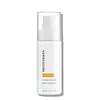What's inside
What's inside
 Key Ingredients
Key Ingredients

 Benefits
Benefits

 Concerns
Concerns

 Ingredients Side-by-side
Ingredients Side-by-side

Water
Skin ConditioningDimethicone
EmollientNiacinamide
SmoothingGlycerin
HumectantPropylene Glycol
HumectantPolysilicone-11
Silica
AbrasiveBis-PEG/PPG-16/16 PEG/PPG-16/16 Dimethicone
EmollientCystoseira Tamariscifolia Extract
Skin Conditioning2-Mercaptonicotinoyl Glycine
Skin ConditioningPEG-20 Methyl Glucose Sesquistearate
EmulsifyingSodium Hyaluronate
HumectantSodium Hydroxide
BufferingSodium Thiosulfate
Carnosine
Skin ConditioningPoloxamer 338
EmulsifyingAmmonium Polyacryloyldimethyl Taurate
Emulsion StabilisingDipotassium Glycyrrhizate
HumectantCaprylic/Capric Triglyceride
MaskingCapryloyl Salicylic Acid
ExfoliatingCaprylyl Glycol
EmollientCitric Acid
BufferingTrisodium Ethylenediamine Disuccinate
Xanthan Gum
EmulsifyingPentylene Glycol
Skin ConditioningOctyldodecanol
EmollientRetinyl Palmitate
Skin ConditioningTocopherol
AntioxidantPentaerythrityl Tetra-Di-T-Butyl Hydroxyhydrocinnamate
AntioxidantPhenoxyethanol
PreservativeCI 17200
Cosmetic ColorantParfum
MaskingWater, Dimethicone, Niacinamide, Glycerin, Propylene Glycol, Polysilicone-11, Silica, Bis-PEG/PPG-16/16 PEG/PPG-16/16 Dimethicone, Cystoseira Tamariscifolia Extract, 2-Mercaptonicotinoyl Glycine, PEG-20 Methyl Glucose Sesquistearate, Sodium Hyaluronate, Sodium Hydroxide, Sodium Thiosulfate, Carnosine, Poloxamer 338, Ammonium Polyacryloyldimethyl Taurate, Dipotassium Glycyrrhizate, Caprylic/Capric Triglyceride, Capryloyl Salicylic Acid, Caprylyl Glycol, Citric Acid, Trisodium Ethylenediamine Disuccinate, Xanthan Gum, Pentylene Glycol, Octyldodecanol, Retinyl Palmitate, Tocopherol, Pentaerythrityl Tetra-Di-T-Butyl Hydroxyhydrocinnamate, Phenoxyethanol, CI 17200, Parfum
Water
Skin ConditioningAcetyl Glucosamine
Skin ConditioningButylene Glycol
HumectantAlcohol Denat.
AntimicrobialNiacinamide
SmoothingPolysorbate 80
EmulsifyingDimethicone PEG-7 Phosphate
CleansingLavandula Angustifolia Flower/Leaf/Stem Extract
Masking4-Butylresorcinol
AntioxidantGlycyrrhiza Glabra Root Extract
BleachingTetrahexyldecyl Ascorbate
AntioxidantPrunus Armeniaca Fruit Extract
Skin ConditioningCitrus Aurantium Dulcis Fruit Extract
MaskingJasminum Officinale Flower/Leaf Extract
MaskingCitrus Aurantium Dulcis Peel Extract
Emulsion StabilisingElettaria Cardamomum Seed Extract
PerfumingVanilla Planifolia Fruit Extract
Skin ConditioningPlumeria Rubra Flower Extract
Skin ConditioningHedychium Spicatum Extract
Skin ConditioningHibiscus Abelmoschus Seed Extract
MaskingGardenia Taitensis Flower Extract
Skin ConditioningPyrus Malus Fruit Extract
Skin ConditioningEugenia Caryophyllus Flower Extract
AstringentCaprylic/Capric Triglyceride
MaskingHydroxyethylcellulose
Emulsion StabilisingCaprylyl Glycol
EmollientSodium Bisulfite
AntioxidantChlorphenesin
AntimicrobialPhenoxyethanol
PreservativeLinalool
PerfumingLimonene
PerfumingHydroxycitronellal
PerfumingBenzyl Alcohol
PerfumingCI 17200
Cosmetic ColorantCI 19140
Cosmetic ColorantWater, Acetyl Glucosamine, Butylene Glycol, Alcohol Denat., Niacinamide, Polysorbate 80, Dimethicone PEG-7 Phosphate, Lavandula Angustifolia Flower/Leaf/Stem Extract, 4-Butylresorcinol, Glycyrrhiza Glabra Root Extract, Tetrahexyldecyl Ascorbate, Prunus Armeniaca Fruit Extract, Citrus Aurantium Dulcis Fruit Extract, Jasminum Officinale Flower/Leaf Extract, Citrus Aurantium Dulcis Peel Extract, Elettaria Cardamomum Seed Extract, Vanilla Planifolia Fruit Extract, Plumeria Rubra Flower Extract, Hedychium Spicatum Extract, Hibiscus Abelmoschus Seed Extract, Gardenia Taitensis Flower Extract, Pyrus Malus Fruit Extract, Eugenia Caryophyllus Flower Extract, Caprylic/Capric Triglyceride, Hydroxyethylcellulose, Caprylyl Glycol, Sodium Bisulfite, Chlorphenesin, Phenoxyethanol, Linalool, Limonene, Hydroxycitronellal, Benzyl Alcohol, CI 17200, CI 19140
 Reviews
Reviews

Ingredients Explained
These ingredients are found in both products.
Ingredients higher up in an ingredient list are typically present in a larger amount.
This ingredient is an emollient, solvent, and texture enhancer. It is considered a skin-softener by helping the skin prevent moisture loss.
It helps thicken a product's formula and makes it easier to spread by dissolving clumping compounds.
Caprylic Triglyceride is made by combining glycerin with coconut oil, forming a clear liquid.
While there is an assumption Caprylic Triglyceride can clog pores due to it being derived from coconut oil, there is no research supporting this.
Learn more about Caprylic/Capric TriglycerideCaprylyl Glycol is a humectant and emollient, meaning it attracts and preserves moisture.
It is a common ingredient in many products, especially those designed to hydrate skin. The primary benefits are retaining moisture, skin softening, and promoting a healthy skin barrier.
Though Caprylyl Glycol is an alcohol derived from fatty acids, it is not the kind that can dry out skin.
This ingredient is also used as a preservative to extend the life of products. It has slight antimicrobial properties.
Learn more about Caprylyl GlycolCi 17200 is a synthetic reddish-purple dye.
Niacinamide is a multitasking form of vitamin B3 that strengthens the skin barrier, reduces pores and dark spots, regulates oil, and improves signs of aging.
And the best part? It's gentle and well-tolerated by most skin types, including sensitive and reactive skin.
You might have heard of "niacin flush", or the reddening of skin that causes itchiness. Niacinamide has not been found to cause this.
In very rare cases, some individuals may not be able to tolerate niacinamide at all or experience an allergic reaction to it.
If you are experiencing flaking, irritation, and dryness with this ingredient, be sure to double check all your products as this ingredient can be found in all categories of skincare.
When incorporating niacinamide into your routine, look out for concentration amounts. Typically, 5% niacinamide provides benefits such as fading dark spots. However, if you have sensitive skin, it is better to begin with a smaller concentration.
When you apply niacinamide to your skin, your body converts it into nicotinamide adenine dinucleotide (NAD). NAD is an essential coenzyme that is already found in your cells as "fuel" and powers countless biological processes.
In your skin, NAD helps repair cell damage, produce new healthy cells, support collagen production, strengthen the skin barrier, and fight environmental stressors (like UV and pollution).
Our natural NAD levels start to decline with age, leading to slower skin repair, visible aging, and a weaker skin barrier. By providing your skin niacinamide, you're recharging your skin's NAD levels. This leads to stronger, healthier, and younger looking skin.
Another name for vitamin B3 is nicotinamide. This vitamin is water-soluble and our bodies don't store it. We obtain Vitamin B3 from either food or skincare. Meat, fish, wheat, yeast, and leafy greens contain vitamin B3.
The type of niacinamide used in skincare is synthetically created.
Learn more about NiacinamidePhenoxyethanol is a preservative that has germicide, antimicrobial, and aromatic properties. Studies show that phenoxyethanol can prevent microbial growth. By itself, it has a scent that is similar to that of a rose.
It's often used in formulations along with Caprylyl Glycol to preserve the shelf life of products.
Water. It's the most common cosmetic ingredient of all. You'll usually see it at the top of ingredient lists, meaning that it makes up the largest part of the product.
So why is it so popular? Water most often acts as a solvent - this means that it helps dissolve other ingredients into the formulation.
You'll also recognize water as that liquid we all need to stay alive. If you see this, drink a glass of water. Stay hydrated!
Learn more about Water